Guitar Chords for the Likes of You Again
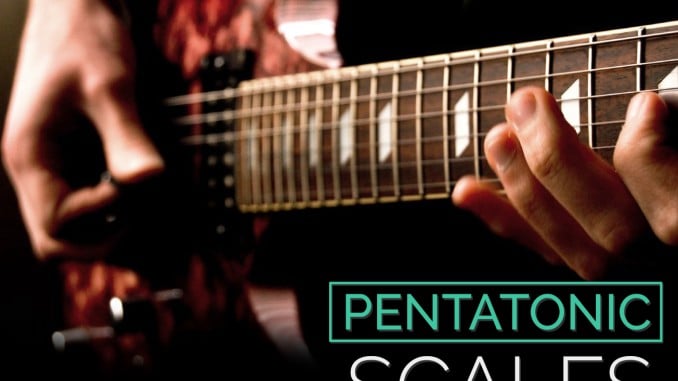
Learn the major and minor pentatonic scales, their patterns, when to use them, and why they're the scale shortcut.
Pentatonic Scale Name
Pentatonic scales contain five notes, which is how it gets its proper noun (Penta=5, tonic = tones). There is a major pentatonic calibration and a small pentatonic calibration. The crawly part is that they incorporate the same note intervals (with differing roots), so the patterns are the same. Yous but need to learn a new root notation.
Pentatonic Scales Are the Calibration Shortcut
In that location are a few reasons that the penatonic scales are the short cutting for the scales.
- You tin can learn the same exact patterns for both. You lot simply need to know how the root note changes in the pattern.
- You can play the major pentatonic scale over almost whatever major or dominant chord without clashing with the chord.
- You lot tin can play the minor pentatonic scale over nearly any pocket-size chord without ambivalent with the chord.
- Sometimes you lot tin can play both scales over the same chord, especially for a bluesy audio.
Isn't that an exciting and simple formula for success? This is why pentatonic scales are so popular.
Did you know the dejection scale is based off the modest pentatonic scale. It but adds one note. Learn more in my blues scale lesson.
Play Over Major Chords
Play the major pentatonic scale over major chords.
For example, over C Major you lot could play the C Major pentatonic calibration.
Some people merits that you lot can play the C pocket-size pentatonic calibration for a bluesy sound. Yes, you can, but you should be mindful of the notes you are playing. The minor pentatonic scale has a minor tertiary (or b3) while the major chord as a major third. This notation can clash, just you lot tin can curve the minor third up a one-half stride to a major third, which is a common tactic by blues guitarists.
Playing Over Minor Chords
Use the pocket-size pentatonic calibration over minor chords.
For example, play A small-scale pentatonic over an A modest chord.
Playing Over Dominant Chords
You can utilise both major and minor pentatonic scales, just once again, be cautious of the minor third when playing the minor pentatonic scale.
For example, you tin can play C Major pentatonic or C minor pentatonic over a C7 chord.
Dominant chords have a major third and a pocket-sized seventh (b7). The minor pentatonic scale has a modest third, which may clash with the chord's small-scale third. Once once more, bending the pocket-sized third up to the major tertiary is a overnice bluesy sound. In this case, the small-scale pentatonic scale contains the minor seventh, and so that notation sounds great.
The Major pentatonic calibration does not have any clashing notes.
Advanced Note
If y'all are a fan of Jimi Hendrix, you know that he likes to play a Dominant7#9 chord. The nine is also called the 2d. The #9 is enharmonically the same equally a minor third (b3). In other words, if yous encounter this chord, it implies that you should play the minor pentatonic scale since it has a minor third.
Playing in a Fundamental
I am charily going to make a recommendation hither. Since the chords alter, you can follow my rules beneath and be safety. All the notes should audio fine. Just call up that some notes volition sound improve than others depending on current chord.
In a major key, play the major pentatonic scale and its relative minor interchangably. In the cardinal of C, you would play the C Major pentatonic scale or the A minor pentatonic scale.
In a minor fundamental, play the small-scale pentatonic scale.
How to Form the Scale
I simply told y'all that yous can utilise the same patterns, merely the difference is where they start. For instance, if you employ the C Major Pentatonic Scale, the matching pocket-size pentatonic scale is the A minor pentatonic scale. Information technology is 3 frets or semitones downwardly from C. If you know your relative minor scales, A is the relative small of C. Let's take a expect at two box patterns.
Example of a Pentatonic Box Pattern – the Same Notes
Take a look at these two pop pentatonic box patterns. Yous'll note that they're the same except the root note location is 3 frets down for the minor pentatonic calibration. If you're familiar with the CAGED chords, you'll notice that this box pattern relates to the Thousand form and the E form respectively. I will show you the box patterns for all the CAGED forms after.
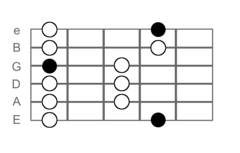
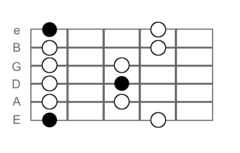
What this means is that you need to know exactly five box patterns for both scales. I will cover patterns in greater depth below.
Forming Pentatonic Scales in Parallel
Some other way to course the calibration is in parallel, using the same root notation rather than the relative minor. In my stance, this is useful for learning the notes of the calibration rather than simply the blueprint. To class the scales in parallel, y'all can take the major calibration and utilise the formulas in the tabular array below.
For case, the C major scale is C-D-E-F-G-A-B. To form the C Major pentatonic scale, you would take the 1 = C, 2 = D, 3 = E, five = G, 6 = A. To form the C minor pentatonic scale, yous would have the 1 = C, b3 = Eb, four = F, 5 = G, b7 = Bb. You will notice that the notes are not the same because only the relative minor pentatonic scale has the same notes. In this instance, it is A minor pentatonic which is A, C, D, Due east, G (the aforementioned notes as C Major Pentatonic).
| Scale | Notation Degrees (Based on the Major Scale) |
| Major Pentatonic | one-2-3-five-half-dozen |
| Minor Pentatonic | 1-b3-iv-5-b7 |
Major Pentatonic Box Patterns
These are the five CAGED box patterns for the Major Pentatonic Scale. Tin you lot choice out the major chords associated with the forms? You'll find that all the chord tones are in that location!
 1000-class Box | 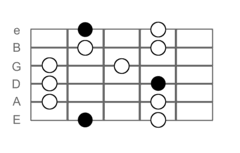 E-form Box | 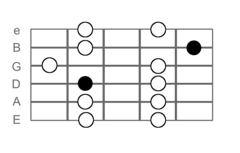 D-class Box |
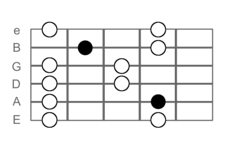 C-form Box | 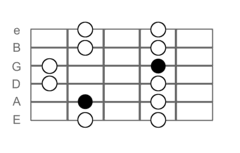 A-form Box |
Small Pentatonic Box Patterns
These are the five CAGED box patterns for the small pentatonic scale. Detect that the root annotation location changes. Because the root note changes, you'll also notice that the "chord form" changes also. The E minor box class is the same as the M Major box form. Some people avoid teaching CAGED for these boxes to avoid defoliation. I recollect it'due south best to associate the chord class, which you should know, to the proper box patterns.
 Eastward-form Box | 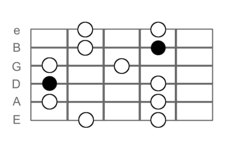 D-form Box | 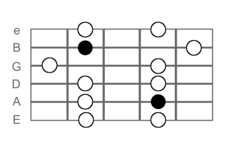 C-form Box |
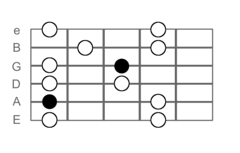 A-course Box | 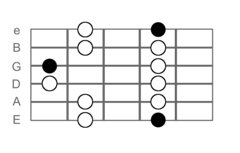 One thousand-form Box |
Single-Octave Box Patterns
Some other method of learning the pentatonic box patterns is to utilise single octave patterns. If you know how to motility unmarried-octave box patterns around the fretboard, yous can apply these two patterns to simplify the learning procedure.
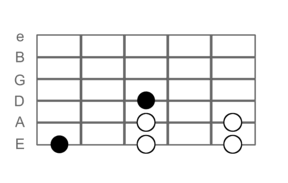 | 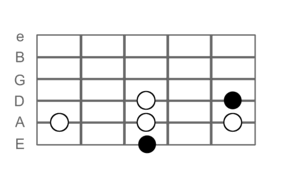 |
Diagonal Major Pentatonic Calibration Patterns
The single-octave patterns can exist linked to produce two diagonal patterns, each repeated iii times. The figure below shows 2 diagonal major pentatonic patterns. The two combine to provide a pattern with a root on each string.


Diagonal Small-scale Pentatonic Scale Patterns
Similarly, the single-octave minor pentatonic pattern can be repeated to class two diagonal scales with roots on every string! Tin can y'all identify where these diagonal patterns fit the box patterns? As an exercise, I recommend finding where the box patterns fit into these diagonal scales.


Determination
One time you know the pentatonic scales, you are ready to play the blues. I highly recommend that you check out my 12 bar blues lesson to start improvising. Y'all can also incorporate some blues licks. You lot can find some licks in my Licks, Riffs, and Tricks section.
If you liked this lesson, please permit me know how I can amend information technology. If yous desire to acquire more nigh chords, scales, and theory, check Guitar Lesson World The Book.
Source: https://www.guitarlessonworld.com/lessons/pentatonic-scales/
0 Response to "Guitar Chords for the Likes of You Again"
Enregistrer un commentaire